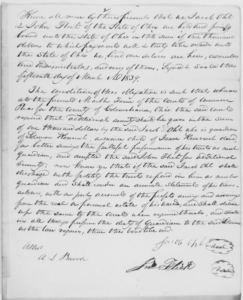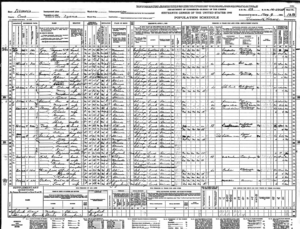Finding Next-of-Kin Using United States Sources, Part 2
 8
8Feb
This article is a continuation of “Finding Next-of-Kin Using United States Sources, Part 1.” In the previous article, finding next-of-kin was introduced, and newspaper records—a key source—were discussed in some depth. Step 1 was to identify next-of-kin. Part two continues with further types of records in the United Sates and how these are useful to discover next-of-kin.
STEP 1 Continued
Probate records

Probate records are records filed with a court after the death of an individual to help settle their estate. The most well known of these is a last will and testament. Many other records usually exist in a person’s probate file as well. These could include lists of all next-of-kin with their addresses, the death certificate of the decedent, notes about any child who predeceased the decedent and any surviving children of that child (the decedent’s grandchildren), etc. Like obituaries, these sometimes provide all a researcher would need to locate the next-of-kin. Of course, for a forensic genealogist working on an unknown heirs case, the probate file for the person of interest will not have the information needed, because the point of finding unknown heirs is that these persons are unknown to the probate court. The file is still worth checking as it may have clues others overlooked. Likewise, probate files of other family members will likely prove useful. For many years, probate records were one of the most genealogically valuable record sets in the United States that had not been put online in large numbers. In recent years that has changed. Most counties in the United States now have at least some of their older probate records digitized and searchable online. The most notable large collections are on Ancestry.com since 2015, and FamilySearch.org (added over time). The search fields available may deceptively suggest to the beginner that all they need to do is to enter a name. The reality is that even the indexed portions are only partially indexed, so that the researcher will need to digitally go page by page through the records to find the desired probate records. Fortunately, Ancestry has provided a useful introduction to navigating the records in their video Navigating Wills and Probates. Even with this wealth of online probates, the researcher will encounter missing records. This lack of online availability is especially true for recent years, the period for which researchers of next-of-kin are most likely to be interested. One simple way to locate the records is to use a search engine like Google to search terms such as: probate court [name of county] county [name of state]. This will help the researcher locate the government website for the agency in charge of probate records for the jurisdiction of interest. Although older records have often been transferred to another location such as a state or local archives, recent records will almost always still be with the court. The court’s website will frequently include a searchable index that the researcher can use to pinpoint a probate of interest. Copies of the record can then be requested from the court staff. Fees and available services will vary.
Census records

The 1940 census is particularly useful because many of the persons whose next-of-kin a researcher is looking for were likely born close enough to 1940 that the researcher may find a likely family. These may be parents and older siblings of the same surname and may add to a list of possible families to pursue. Some were born before 1940, and the researcher may find their person of interest as a child in this census. This might show the person of interest with his parents and siblings. In the United States, census records become public after 72 years. The 1950 census will become available in 2022. Some state and local census records exist which could help bridge the gap to the present. Large collections include the 1945 Florida and South Dakota state censuses. For records that are too recent to be publicly available, access may still be possible in some cases. Always consider potential ways to work around these issues of access, including Freedom of Information requests. One frequently useful method to access private records is to have one of the qualifying family members or their legal representatives make an official request. If there is a qualifying person willing to do this, it is possible to make a request for federal census records within the 72-year privacy period. If a researcher needs to find someone’s grandparents, the census records are very useful. The more difficult part is to bridge that gap between available census records (1940) and actually finding next-of-kin.
Death certificates
Death certificates have a field called “informant” which is often the name of a close family member—the person who provided the information on the certificate. This could provide the married surname of a daughter, the residence of a child at that time, or might be a name of a relative that was previously unknown.
Cemetery records
Cemeteries almost always have records of plot owners. If the researcher can find a burial—let’s say of the family’s grandparents—the researcher can then get the name of the plot owner, who was often a child of the person buried. Sometimes the researcher will find that these records list the owner plus one or more other living relatives. Sometimes those who have inquired about burial information previously are listed. At times these living people have information in the cemetery records such as their date of birth and their address.
Funeral Homes
Funeral homes and mortuaries kept financial records and forms for family information that may contain a lot of extra information. The name of the church where the funeral service occurred may lead the researcher to church records. The clergyman who officiated is often mentioned. Military service, occupation, and social security information may be recorded, as well as the raw notes that were written in preparation for an obituary. If the person was part of a fraternal organization or club or lodge, this would be helpful. Names of pallbearers, an insurance company, and the grave location are typically noted. Perhaps submitting a notice in a parish, school, or other organization’s newsletter or magazine asking to contact anyone who remembers an individual or family would bring a positive response. A Google search, the local library, or the American Blue Book of Funeral Directors will provide contact information.
Immigration files
The United States Citizenship and Immigration Services (USCIS) alien files and other records are extremely valuable for tracing a line in which there is a recent immigrant who has come over in the mid-1900s, especially if they have since passed away. This will allow the researcher to request the immigrant’s file under Freedom of Information laws. These files often list many genealogical details, residences, and even family members in the United States, as well as in the country of origin.
Social Security Applications
SS-5 cards are the forms which people filled out when applying for social security cards. In recent years, parents fill these out for children when they are born. A few decades ago, individuals filled these out themselves. These cards will give a specific residence at a specific time, birth date, birth place, and names of the individual’s parents. These can easily be ordered online for a fee from the Social Security Administration. Ancestry.com has many Social Security Applications on their website. It would be worthwhile to check Ancestry before ordering the application.
Church records and other privately held records
Church records are private records. Although most current-generation records are not online, if a researcher is able to travel or send an agent to do research, many churches will allow access to their current records. The same is true for some clubs, businesses, and other organizations that could have useful clues in their records.
The most successful researchers will be thorough and analytical with their research, leaving no stone unturned. Even for those already quite experienced, it is a good reminder to refer to resources like the FamilySearch Wiki, “United States Record Finder,” for ideas on additional sources.
STEP 2: Locate next-of-kin
As mentioned in part one of this series, next-of-kin research can be roughly broken into two steps. Step one was discussed in part one as “Identify next-of-kin,” which this article continues to develop. After identifying the individuals, the next step is to locate correct current contact information, then reach out to them if desired. These two steps often overlap. Following are some methodologies of locating next-of-kin, and are discussed in the context of particular record types.
Court records
One record type where this overlap occurs is court records. Online indexes of court records can lead to a person’s current contact information. Court records fall into the first step (identification of the next-of-kin) as one analyzes these records. It is sometimes possible to determine relationships of living and deceased individuals, as well as to discover previously unknown names.
Using court records for next-of-kin research differs in significant ways from using them for traditional genealogy research. Traditional genealogists often use microfilms or digital images of original court books, or use the court books in a courthouse itself. When researching next-of-kin, these formats should not be ignored. However, when researching the present generation in court records, it is more typical to find names available in online indexes. In many instances, additional computerized indexes are available in person at the courthouse. It is common to find that a court’s online indexes cover the most recent two to five decades. Some courthouses have been quite diligent in uploading indexes or records that go back to the beginning of their county, though they are more likely to cover recent decades. Traditional genealogists may overlook the great wealth of indexes of information covering current generations on court websites. These databases contain a variety of items, such as simple ordinance violations, and thus have broad coverage of the population. In addition to miscellaneous court records, there are other types of records traceable in the databases of local courthouses, such as land records. The local government often has a property tax database online that can be used to locate living individuals.
Lists, phone books, city directories, and other people finders
There are other organizations and government agencies which list people in online databases or publications. Many of these sources are more useful for locating correct current addresses than they are for determining next-of-kin. Certainly, they can be helpful to find the next-of-kin. For example, tracing people who all reside at the same address may infer their relationships. Many traditional genealogists are familiar with using city directories of the late 1800s or early 1900s, but may not know that city directories are still published today in some areas. Where city directories are difficult to find, or do not exist, phone directories are a good substitute.
Many additional sources are primarily used to locate or contact the next-of-kin, once it is determined who they are. All these sources possibly can help identify previously unknown next-of-kin. This is typically done by finding people linked together in some ways. Pay attention to people living at the same address, in the same city (if the surname is rare), or linked together on social media. The researcher should keep these possibilities in mind, instead of viewing these sources solely as ways to contact people whose identity is already known.
Michael
